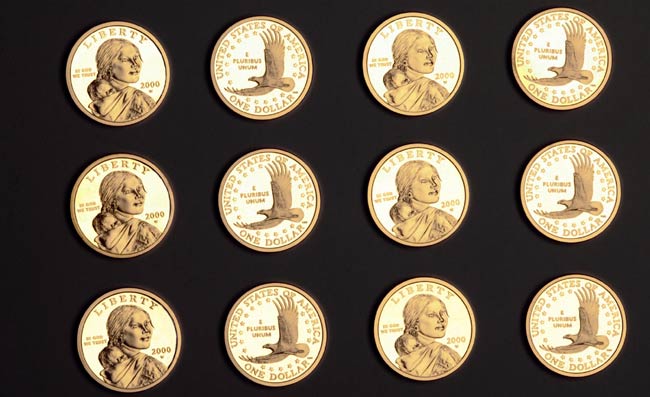U.S. Mint to Unveil Unseen Space Coins

Six monthsbefore the U.S. Mint issued the first Sacagawea dollar coins on January 27,2000, 12 specially-minted 22 karat gold Sacagaweas made a launch of a verydifferent type.
The dozendollars were carried in to orbit aboard the space shuttle Columbia tocommemorate the flight of Eileen Collins,the first female U.S. astronaut to command a spaceflight.
The 12well-traveled coins ? 1.8 million miles (2.8 million kilometers)over the course of 80 orbits in 4 days, 22 hours and 50 minutes ? were chosenas the best strikes from a set of 39 dollars struck at the Mint's West Point,New York facility in June 1999. The remaining 27 coins were destroyed.
Originally, the Mint had planned to exhibit the gold coins at museums topromote the release of the Sacagawea dollar and potentially the sale of similargold versions to the public. The gold coins' creation however, hadn't been toregulation, and the marketing program was canceled.
Instead, the 12 space flown coins were moved to the Fort Knox Bullion Depositoryin 2001, where they have been in storage since.
That is, until August 10, 2007, when the U.S. Mint plans to publicly displaythe dozen doubloons for the first time. The 12 gold versions of the circulatinggolden dollars will be unveiled at the American Numismatic Association's World'sFair of Money in Milwaukee, Wisconsin, the largest coin show in the nation.
The Mint's Director Ed Moy will preside over a ceremony at the Midwest AirlinesConvention Center, where he will make remarks and sign commemorative cardsinside the Mint's booth (#1201).
Get the Space.com Newsletter
Breaking space news, the latest updates on rocket launches, skywatching events and more!
Unlike the 12 gold coins, which were minted from 9167 (half-ounce) fine gold,the Sacagawea circulating dollars are only golden-color. The issued coins arecomprised of a three-layer clad construction: pure copper sandwiched betweenand bonded to outer layers of manganese brass.
All the coins bear the three-quarter profile of Sacagawea, the Shoshone Indianwho assisted the historic Lewis and Clark expedition. Between 1804 and 1806,she guided the adventurers from the Northern Great Plains to the Pacific Oceanand back.
The 12 coins that flew in space were on STS-93, the 94th shuttle mission, the 26th flightof Columbia and the 21st shuttle night launch from Kennedy Space Center,Florida. In addition to marking the first mission commanded by a woman(Collins), the flight deployed the third of NASA's four "GreatObservatories", the ChandraX-Ray telescope. STS-93 flew for five days between July 23 and 27, 1999.
- VIDEO Archive: NASA?s STS-93 Mission
- Top 10 Chandra Pictures
- Complete Space Shuttle Mission Coverage
Copyright 2007 collectSPACE.com. All rights reserved.

Join our Space Forums to keep talking space on the latest missions, night sky and more! And if you have a news tip, correction or comment, let us know at: community@space.com.

Robert Pearlman is a space historian, journalist and the founder and editor of collectSPACE.com, a daily news publication and community devoted to space history with a particular focus on how and where space exploration intersects with pop culture. Pearlman is also a contributing writer for Space.com and co-author of "Space Stations: The Art, Science, and Reality of Working in Space” published by Smithsonian Books in 2018.In 2009, he was inducted into the U.S. Space Camp Hall of Fame in Huntsville, Alabama. In 2021, he was honored by the American Astronautical Society with the Ordway Award for Sustained Excellence in Spaceflight History. In 2023, the National Space Club Florida Committee recognized Pearlman with the Kolcum News and Communications Award for excellence in telling the space story along the Space Coast and throughout the world.









